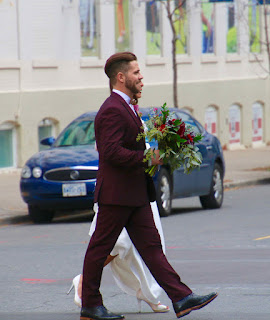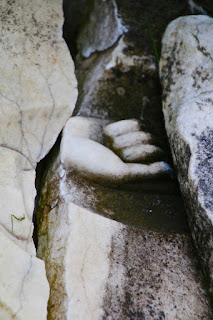Dear Reader: This posting explores ambiguity, crying,
and an ordinary Australian rainbow; it is not traditional Christmas fare. I
understand if you stop reading now and pour yourself an eggnog instead. For
those readers who keep reading, I thank you for indulging me.
Les Murray is an Australian poet. Born in 1938, he continues
to write and has been nominated for the Nobel Prize for literature. His 1969
poem, “An Absolutely Ordinary Rainbow”, appears at the end of this posting. I
struggle with Les Murray’s poems and find myself wanting to like them more than
I do – except for “An Absolutely Ordinary Rainbow,” which is deeply evocative for
me.
Background:
I lived in Sydney, Australia in the early 1970s. I
love the city and visit it whenever my bank account allows. It is a boisterous,
unruly place whose history is an amalgam of nobility, tragedy, and greed. The
breathtaking beauty of its harbour renders me speechless.
The Central Business District (CBD) is located just
south of the Sydney Opera House and the Harbour Bridge. In the heart of the CBD
is Martin Place, a wide pedestrian mall that runs east-west for several blocks.
It is a glorious place for walking, flirting, lunching, and flower-buying. For
me, it is the essential heartbeat of the city. At the west end, in front of the
former General Post Office, is the Sydney Cenotaph, which honours the war dead
of New South Wales in overseas conflicts. At dawn on ANZAC (Australia-New
Zealand Army Corps) Day, April 25, thousands gather at the cenotaph to commemorate
the futile 1915 Battle of Gallipoli, in which 26,111 Australian soldiers were
wounded and 8,141 died. It is a foundational event in Euro-Australian history.
Some of my most pleasant memories of Sydney are the
times I spent drinking coffee while reading the Sydney Morning Herald at the Lindt Café on Martin Place, three
short blocks east of the Cenotaph. It is also the scene of the December 15,
2014, “Sydney Siege,” in which a lone gunman held 18 people hostage for 16 hours.
In the end, three people died, including the gunman. Originally thought to be
an act of ISIL-related terrorism, many now believe it was the work of a single
radicalized man who suffered from severe mental health issues.
I tell you these details for very personal reasons: it
was the first time that an act of terrorism had taken place in a physical
location that I knew intimately. Suddenly, the headlines struck home. Someone
had grabbed a piece of my peaceful world and desecrated it. In writing this, I
don’t want to imply that my sense of personal violation equals the horrifying
experience of the hostages or emergency responders. Not at all. But the events
at the Martin Place Lindt Café pierced my soul and left me feeling deeply
ambiguous: when Bill and I visit Sydney in April, I want to return to that café
on Martin Place and reclaim it as my own. At the same time, I also feel
ghoulish, like one of those disaster freaks who visits the sites of atrocities around
the globe, collecting them like knickknacks. As I said, ambiguous.
Which me brings me to Les Murray’s poem, “An Absolutely
Ordinary Rainbow.” You see, his poem – written in 1969, long before the 2014 events
at the Lindt Café – focuses on a man who is crying in Martin Place. In the strutting
macho culture that stunts too many Australians, a grown man crying in public
was rare indeed. Crying was seen as weakness – too ‘womanly’ for a real
Australian man.
And crying is the element that ties all these thoughts
together: crying for the people who died at the Lindt Café, crying for the
soldiers who died at Gallipoli, crying for Australia…and crying for myself.
These days, I explore emotions with photographs,
finding photography to be a powerful medium for processing conflicted feelings.
The images that follow are a response to Les Murray’s poem, to the hostage
events at the Lindt Café, and to my own ambiguity about returning to Martin
Place in April.
After you look at the photos, I invite you to read “An
Absolutely Ordinary Rainbow,” which follows the photos. I am interested in
hearing your feedback to this posting, to whose themes I may return in the
future. There’s more ambiguity to explore.
With every best wish for health and happiness in the
year ahead.
To scaffold your reading of the poem, here are
explanations of some references:
Repins was a coffee shop near Martin Place.
Lorenzinis was a well-known wine bar.
Tattersalls and the Greek Club were gathering places for
businessmen.
As for the significance of the title, who knows?
An Absolutely Ordinary Rainbow
By Les
Murray
The word goes round Repins,
the murmur goes round Lorenzinis,
at Tattersalls, men look up from sheets
of numbers,
the Stock Exchange scribblers forget
the chalk in their hands
and men with bread in their pockets
leave the Greek Club:
There's a fellow crying in Martin
Place. They can't stop him.
The traffic in George Street is banked
up for half a mile
and drained of motion. The crowds are
edgy with talk
and more crowds come hurrying. Many run
in the back streets
which minutes ago were busy main
streets, pointing:
There's a fellow weeping down there. No
one can stop him.
The man we surround, the man no one
approaches
simply weeps, and does not cover it,
weeps
not like a child, not like the wind,
like a man
and does not declaim it, nor beat his
breast, nor even
sob very loudly—yet the dignity of his
weeping
holds us back from his space, the
hollow he makes about him
in the midday light, in his pentagram
of sorrow,
and uniforms back in the crowd who
tried to seize him
stare out at him, and feel, with
amazement, their minds
longing for tears as children for a
rainbow.
Some will say, in the years to come, a
halo
or force stood around him. There is no
such thing.
Some will say they were shocked and
would have stopped him
but they will not have been there. The
fiercest manhood,
the toughest reserve, the slickest wit
amongst us
trembles with silence, and burns with
unexpected
judgements of peace. Some in the
concourse scream
who thought themselves happy. Only the
smallest children
and such as look out of Paradise come
near him
and sit at his feet, with dogs and
dusty pigeons.
Ridiculous, says a man near me, and
stops
his mouth with his hands, as if it uttered
vomit—
and I see a woman, shining, stretch her
hand
and shake as she receives the gift of
weeping;
as many as follow her also receive it
and many weep for sheer acceptance, and
more
refuse to weep for fear of all
acceptance,
but the weeping man, like the earth,
requires nothing,
the man who weeps ignores us, and cries
out
of his writhen face and ordinary body
not words, but grief, not messages, but
sorrow,
hard as the earth, sheer, present as
the sea—
and when he stops, he simply walks
between us
mopping his face with the dignity of
one
man who has wept, and now has finished
weeping.
Evading believers, he hurries off down
Pitt Street.
from
The Weatherboard Cathedral
(Angus & Robertson Publishers, Sydney, 1969)



































